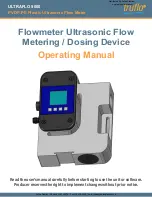
Examples
Store only the accesses to the demo program’s current_humid location:
trace only range current_humid thru +1h
Store only bus cycles where data is in the range 6h..26h or is 29h:
trace only data range 6h thru 26h or data 29h
To use the sequencer
•
Create your first specification form on the command line. That will enter the
proper format in the Trace Specification Selection dialog box. Obtain the dialog
box by choosing Trace
→
Trace Spec... You can click on your specification in the
dialog box, edit it if desired, and click OK.
•
Using the command line, specify a trace sequence by entering:
trace find_sequence <bus_state> occurs <#times> [then
<bus_state>
occurs <#times>] trigger <bus_state>
<bus_state> represents a combination of address, data and status expressions that
must be matched to satisfy the trigger or sequence qualifier. <#times> is the
number of times that bus state must occur to satisfy the qualifier.
The trace sequencer allows you to specify up to seven sequence terms (including
the trigger) that must be satisfied to trigger the analyzer. If you use the windowing
specification, the sequence specification is limited to four sequence terms.
Example
Use the analyzer sequencer to trigger after finding a series of events:
trace find_sequence main then update_sys.get_targets
trigger after proc_spec
Chapter 5: Using the Emulation-Bus Analyzer
Making Complex Trace Measurements
240
Summary of Contents for 64783A
Page 30: ...xxx ...
Page 31: ...Part 1 Quick Start Guide 1 ...
Page 33: ...1 Getting Started 3 ...
Page 70: ...40 ...
Page 75: ...Part 2 Using The Emulator 45 ...
Page 140: ...110 ...
Page 141: ...4 Using the Emulator How to control the processor and view system resources 111 ...
Page 227: ...5 Using the Emulation Bus Analyzer How to record program execution in real time 197 ...
Page 290: ...260 ...
Page 331: ...8 Configuring the Emulator 301 ...
Page 382: ...352 ...
Page 383: ...9 Solving Problems What to do when the emulator doesn t behave as expected 353 ...
Page 397: ...Part 3 Reference 367 ...
Page 399: ...10 Using Memory Management Understanding logical and physical emulation and analysis 369 ...
Page 429: ...11 Emulator Commands The command syntax reference for the emulator softkey interface 399 ...
Page 443: ...copy Chapter 11 Emulator Commands copy 413 ...
Page 451: ...display Chapter 11 Emulator Commands display 421 ...
Page 457: ...DISPLAY MEMORY Chapter 11 Emulator Commands DISPLAY MEMORY 427 ...
Page 461: ...DISPLAY MMU Chapter 11 Emulator Commands DISPLAY MMU 431 ...
Page 464: ...DISPLAY TRACE Chapter 11 Emulator Commands DISPLAY TRACE 434 ...
Page 480: ...modify Chapter 11 Emulator Commands modify 450 ...
Page 501: ...set Chapter 11 Emulator Commands set 471 ...
Page 514: ... SYMB Chapter 11 Emulator Commands SYMB 484 ...
Page 582: ...552 ...
Page 583: ...13 Setting X Resources 553 ...
Page 598: ...568 ...
Page 606: ...576 ...
Page 613: ...16 Specifications and Characteristics 583 ...
Page 627: ...Part 4 Concept Guide 597 ...
Page 629: ...17 X Resources and the Graphical User Interface 599 ...
Page 639: ...Part 5 Installation and Service Guide 609 ...
Page 697: ...19 Installation and Service 667 ...
Page 746: ...Chapter 19 Installation and Service Verifying the Installation 716 ...
Page 755: ...20 Installing Updating Emulator Firmware 725 ...
Page 762: ...732 ...
Page 778: ...748 ...
Page 810: ...X server 554 604 X Window System 54 Index 780 ...
















































